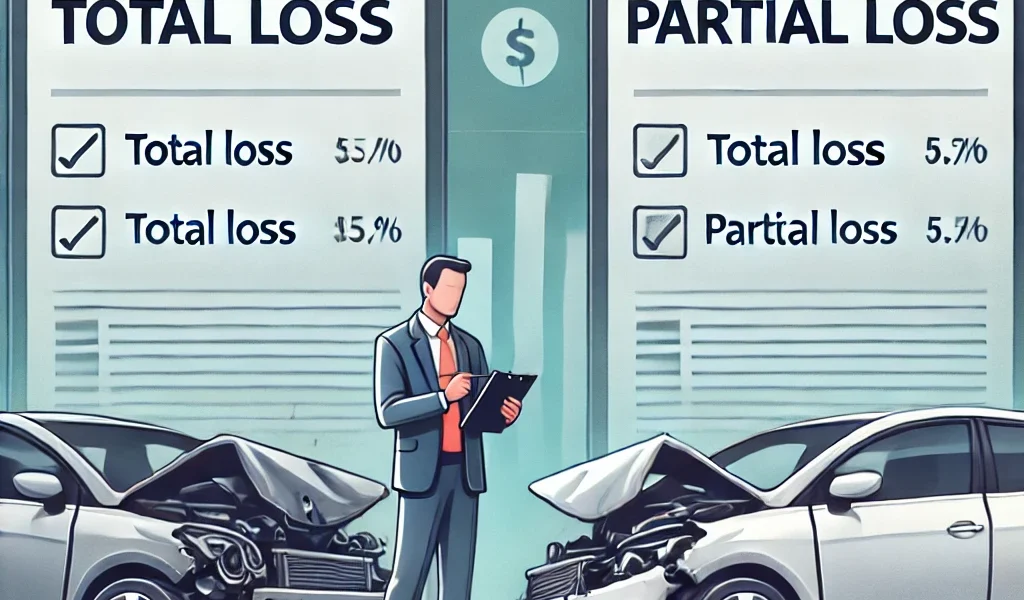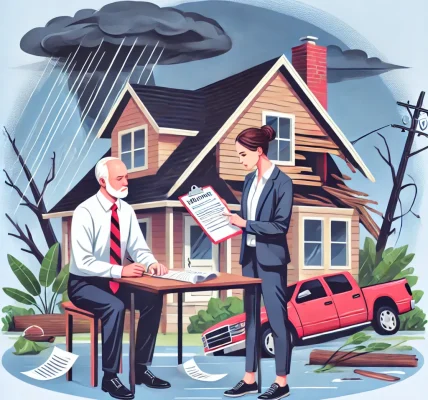Insurance claims can be complicated, especially when determining whether your loss qualifies as a total loss or a partial loss. Understanding the difference is essential to ensuring you receive the correct compensation from your insurance provider.
This DIY guide will help you understand total and partial losses, how they impact your insurance claim, and the steps you can take to maximize your payout.
1. What Is a Total Loss?
A total loss occurs when the cost to repair the damaged property exceeds a certain percentage of its value or if the property is completely destroyed.
Common Examples of Total Loss:
- Auto Insurance: If your car is severely damaged in an accident, and repair costs exceed 70%-80% of its actual cash value (ACV), the insurance company may declare it a total loss.
- Home Insurance: If a house is destroyed by fire, flood, or other disasters, and the repair cost exceeds the home’s insured value, it is considered a total loss.
How Total Loss is Determined:
- Insurer’s Formula: Each insurance company has a specific threshold (e.g., 70%-80% of the asset’s ACV).
- State Regulations: Some states have legal thresholds for when a vehicle or property must be declared a total loss.
- Fair Market Value: Insurers consider the asset’s pre-loss market value when assessing the claim.
What Happens in a Total Loss Claim?
✔ Insurer Pays the Actual Cash Value (ACV): You receive compensation based on your property’s fair market value before the loss. ✔ Salvage Process: If applicable, the insurer may sell the totaled item to a salvage yard or auction it. ✔ Policy Payout Limits Apply: The maximum payout is based on your policy’s coverage.
2. What Is a Partial Loss?
A partial loss occurs when the damage is repairable, and the repair costs do not exceed the insured property’s value.
Common Examples of Partial Loss:
- Auto Insurance: A minor accident results in a broken bumper and dented door that can be repaired.
- Home Insurance: A storm damages part of the roof, but the home is still habitable, and repairs are feasible.
How Partial Loss is Handled:
- Inspection & Estimate: The insurer sends an adjuster to assess the damage and estimate repair costs.
- Deductible Applies: You must pay your deductible before the insurer covers repair costs.
- Depreciation Deduction: Insurers may factor in depreciation, reducing your payout based on the property’s age and wear.
What Happens in a Partial Loss Claim?
✔ Repairs Authorized: The insurer will approve a repair estimate and pay the necessary costs minus the deductible. ✔ Reimbursement for Temporary Costs: Some policies cover temporary living expenses (for homes) or rental cars (for vehicles) while repairs are completed. ✔ Inspection Required: Insurers may require a post-repair inspection to ensure quality repairs.
3. Key Differences Between Total and Partial Loss Claims
| Feature | Total Loss | Partial Loss |
|---|---|---|
| Repair Feasibility | Repairs exceed the insured asset’s value | Repairs cost less than asset’s value |
| Payout | Based on Actual Cash Value (ACV) | Based on repair estimates |
| Salvage Process | Insurer may sell damaged asset for salvage | No salvage involved |
| Depreciation | ACV already accounts for depreciation | Depreciation may affect repair costs |
| Deductible Impact | Deductible applies before payout | Deductible applies to repair costs |
| Common for | Major accidents, disasters, fires | Minor accidents, partial damages |
4. How to Maximize Your Insurance Claim Payout
For Total Loss Claims:
✔ Know Your Asset’s Value: Research your car’s market value or home’s replacement cost before accepting an offer. ✔ Negotiate the Payout: If the insurer’s offer is lower than expected, provide evidence (recent sales, appraisals) to justify a higher payout. ✔ Understand Salvage Value: If you choose to keep your totaled car, understand how salvage value affects your payout.
For Partial Loss Claims:
✔ Get Multiple Repair Estimates: Don’t rely solely on the insurer’s recommended repair shop—compare quotes. ✔ Check for Hidden Damage: Ensure all damages are included in the claim before repairs start. ✔ Request Depreciation Reimbursement: Some policies allow for recovering depreciation after repairs are completed.
5. What If You Disagree with the Insurance Decision?
Steps to Appeal a Claim Decision:
- Review the Insurance Policy: Ensure the insurer’s assessment aligns with your policy’s coverage.
- Provide Additional Evidence: Submit repair estimates, independent appraisals, and expert opinions.
- Negotiate with the Adjuster: Present your case professionally and with supporting documents.
- Request an Independent Appraisal: Some policies include an appraisal clause for dispute resolution.
- File a Complaint: If negotiations fail, consider filing a complaint with the insurance regulatory authority.
Final Thoughts
Understanding the differences between total loss and partial loss claims can help you navigate the insurance process confidently. By knowing your rights, reviewing your policy, and negotiating when necessary, you can ensure you receive fair compensation for your losses.




